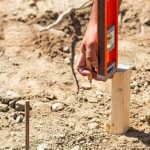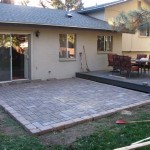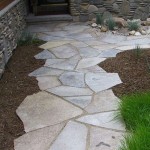```html
How to Renew an Old Concrete Patio
Over time, concrete patios, subject to the elements and regular use, can begin to show signs of wear and tear. Cracks, stains, discoloration, and general deterioration can detract from the aesthetic appeal and even pose safety hazards. Fortunately, revitalizing an old concrete patio is a feasible project for many homeowners. Several techniques, ranging from simple cleaning and sealing to more involved resurfacing options, can restore a patio to its former glory.
Before embarking on any renovation project, a thorough assessment of the patio's condition is crucial. This evaluation will dictate the most appropriate course of action and the necessary materials. Note the extent and type of damage present. Minor surface stains might only require a deep cleaning, while significant cracking may necessitate more comprehensive repair or resurfacing strategies. Understanding the underlying causes of the deterioration, such as poor drainage or inadequate initial construction, is also important to prevent future problems.
Key Point 1: Cleaning and Preparation
The initial stage of any concrete patio renewal project involves thorough cleaning and preparation. This process removes loose debris, dirt, mildew, and existing coatings, providing a clean and stable surface for subsequent treatments. The effectiveness of the cleaning process will directly impact the success of any further renewal efforts.
Begin by sweeping the entire patio area to remove any loose leaves, dirt, or other debris. Use a stiff-bristled broom for optimal cleaning. For more stubborn dirt and grime, a pressure washer can be used. Exercise caution when using a pressure washer, as excessive pressure can damage the concrete surface, especially if it is already weakened. Keep the nozzle at a safe distance and use a wide-angle spray pattern to avoid concentrating the force in one area.
For patios exhibiting mold or mildew growth, apply a specialized concrete cleaner containing a mildewcide. Follow the manufacturer’s instructions carefully, paying attention to dilution ratios and application times. Allow the cleaner to dwell on the surface for the recommended period before scrubbing with a brush and rinsing thoroughly with water. Consider using a cleaner specifically formulated for concrete patios, available at most home improvement stores. These often contain degreasers and other agents that help to remove embedded stains.
Stubborn stains, such as oil or grease, may require more aggressive cleaning methods. Apply a commercial concrete degreaser to the affected area and allow it to penetrate the stain for the recommended time. Scrub vigorously with a stiff brush and rinse thoroughly. For particularly persistent stains, multiple applications may be necessary. Alternative stain removal techniques include the use of poultices, which are absorbent materials mixed with cleaning agents and applied to the stain to draw it out.
After cleaning, carefully inspect the patio for any remaining loose or flaking concrete. Use a chisel and hammer or a wire brush to remove any unstable material. This step is essential to ensure proper adhesion of any patching or resurfacing materials. Once all loose material has been removed, thoroughly rinse the patio again to remove any remaining dust or debris.
If the patio has been previously sealed or coated, the existing coating may need to be removed before applying a new one. This can be achieved through mechanical methods, such as grinding or sanding, or through the use of chemical strippers. Chemical strippers should be used with caution, following all safety precautions and disposal guidelines provided by the manufacturer. Mechanical methods offer a more controlled and environmentally friendly option but may require specialized equipment.
Key Point 2: Repairing Cracks and Damage
Addressing cracks and other damage is crucial for restoring the structural integrity and appearance of an old concrete patio. Neglecting these repairs can lead to further deterioration and potentially unsafe conditions. Selecting the appropriate repair materials and techniques is essential for a long-lasting and aesthetically pleasing result.
The first step in repairing cracks is to widen and clean them. Use a hammer and chisel or a concrete crack chaser to widen the cracks into a V-shape. This provides a wider surface area for the repair material to adhere to. Thoroughly clean the cracks with a brush and vacuum out any loose debris. For hairline cracks, a crack chaser can be used to create a more substantial opening for the repair material.
Once the cracks are prepared, select an appropriate patching material. For small cracks, a concrete crack filler or patching compound can be used. These materials are typically pre-mixed and easy to apply. For larger cracks, a concrete patching mix may be necessary. These mixes consist of cement, sand, and aggregates and need to be mixed with water according to the manufacturer's instructions.
Apply the patching material to the cracks, ensuring that it is packed tightly into the opening. Use a trowel to smooth the surface and blend it with the surrounding concrete. For deeper cracks, it may be necessary to apply the patching material in layers, allowing each layer to dry before applying the next. Once the patching material has dried, sand the surface to create a smooth and even finish.
For more extensive damage, such as large spalled areas or crumbling concrete, a more comprehensive repair may be required. This may involve removing the damaged concrete and replacing it with new concrete. Before patching, consider applying a bonding agent to the old concrete to improve the adhesion of the new concrete. Ensure the patch blends seamlessly with the surrounding area to avoid noticeable imperfections.
In situations where the patio has settled unevenly, causing significant cracking and instability, it may be necessary to consider concrete leveling. This involves injecting a polyurethane foam underneath the concrete slab to lift it back into its original position. Concrete leveling can be a cost-effective alternative to completely replacing the patio, but it should be performed by a qualified professional.
Key Point 3: Resurfacing and Sealing
Resurfacing offers a way to dramatically improve the look of the patio without completely replacing it. Applying a new concrete overlay can conceal existing imperfections, add texture, and even change the color of the patio. Sealing the concrete after resurfacing or even after simple cleaning is crucial for protecting it from the elements and preserving its appearance.
Several resurfacing options exist, each with its own advantages and disadvantages. A concrete overlay is a thin layer of concrete that is applied over the existing patio surface. Overlays can be applied in various thicknesses and textures, allowing for a wide range of design options. Stamped concrete overlays mimic the look of natural stone, brick, or tile. Self-leveling overlays create a smooth, even surface, ideal for patios that are uneven or have significant imperfections.
Before applying a concrete overlay, thoroughly clean and prepare the existing patio surface, as described earlier. Apply a bonding agent to the patio to improve the adhesion of the overlay. Mix the overlay material according to the manufacturer's instructions. Apply the overlay to the patio using a trowel or squeegee, working in small sections. For textured overlays, use stamps or other tools to create the desired pattern. Allow the overlay to dry completely before sealing.
Once the surface is prepared, applying a protective sealer is important. A concrete sealer protects the patio from water damage, stains, and UV rays. Different types of sealers are available, including acrylic sealers, epoxy sealers, and polyurethane sealers. Acrylic sealers are relatively inexpensive and easy to apply, but they are not as durable as epoxy or polyurethane sealers. Epoxy sealers are more durable and resistant to chemicals, but they can be more difficult to apply. Polyurethane sealers offer excellent durability and UV resistance, but they are also the most expensive option.
Before applying the sealer, ensure the concrete surface is clean and dry. Apply the sealer according to the manufacturer's instructions, using a roller or sprayer. Multiple coats may be required for optimal protection. Allow the sealer to dry completely before using the patio. Regularly reapply the sealer to maintain its protective properties. The frequency of reapplication will depend on the type of sealer used and the amount of traffic the patio receives.
In addition to traditional sealers, decorative concrete stains can be used to enhance the appearance of the patio. Concrete stains penetrate the surface of the concrete, creating a permanent color that will not fade or peel. Stains are available in a wide range of colors, allowing for customization and creative design options. Apply the stain according to the manufacturer's instructions, and be sure to seal the concrete after staining to protect the color and prevent fading.
```
3 Concrete Resurfacing Options For Patio

How To Repair And Resurface Old Concrete Patios Fixing Ugly

How To Remove Your Concrete Patio Dumpsters Com

4 Ways To Resurface Concrete In Minutes

How To Re Concrete Patio Diy Right Home Repairs

Resurfacing A Concrete Patio For Budget Diy Makeover Fab Everyday

Ed Concrete See How We Repaired Our Gross Patio 2024

Concrete Resurfacing Restaining Northwest Ar Nwa Floors

Before And After Painted Concrete Patio Thistlewood Farm

Concrete Stain And Sealer Patio Makeover Exchange
Related Posts








